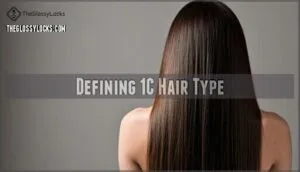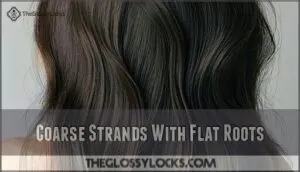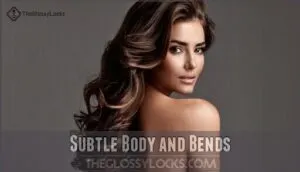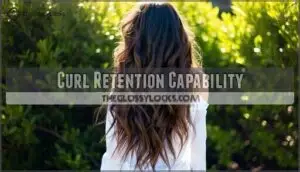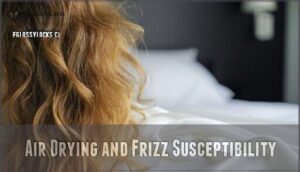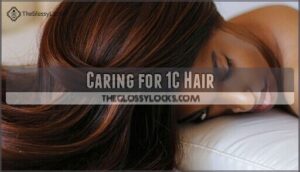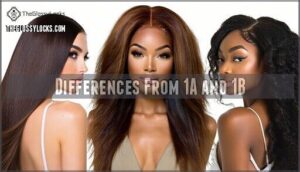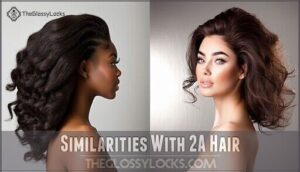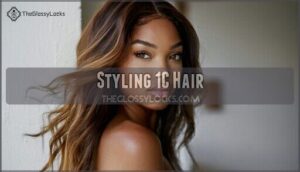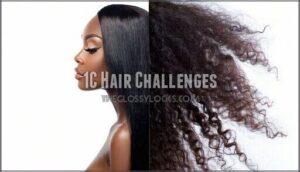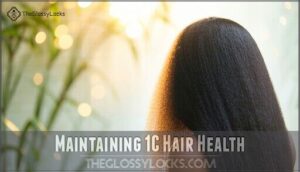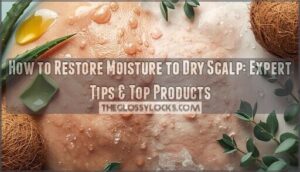This site is supported by our readers. We may earn a commission, at no cost to you, if you purchase through links.

It’s mostly straight at the roots, but as you move down, you’ll notice subtle bends or curves that give it some natural body.
The strands are often coarse, so they feel thicker and can handle a bit more wear and tear, but frizz can still be a frequent visitor—especially if you let it air dry.
This hair type doesn’t hold curls as easily as its wavier cousins, but its natural movement makes it stand out.
Curious about styling tricks or the best care routine? There’s plenty more to explore, including how to manage frizz!
Table Of Contents
- Key Takeaways
- Defining 1C Hair Type
- What is 1C Hair
- 1C Hair Characteristics
- Caring for 1C Hair
- 1C Hair Vs Other Types
- Styling 1C Hair
- 1C Hair Challenges
- Maintaining 1C Hair Health
- Frequently Asked Questions (FAQs)
- How do I tell if my hair is 1B or 1C?
- What is a 1C hair?
- How does humidity affect 1C hair?
- Can diet influence the health of 1C hair?
- Are there any genetic factors in 1C hair texture?
- How does hard water impact 1C hair?
- Can hormonal changes alter 1C hair characteristics?
- What hairstyles work best for 1C hair?
- How does weather impact 1C hair texture?
- What products enhance shine for 1C hair?
- Conclusion
Key Takeaways
- You’ll notice 1C hair is mostly straight with subtle bends or waves, coarse strands, and flat roots that add natural volume.
- Managing frizz is key for 1C hair – focus on lightweight anti-frizz products, deep conditioning, and silk pillowcases to reduce static and dryness.
- It holds some curl and has great styling versatility, but tight ringlets might not last long due to its texture and density.
- Avoid overwashing to prevent dryness, and apply conditioner to the ends to maintain hydration and reduce split ends.
Defining 1C Hair Type
You’ll recognize 1C hair by its straight appearance at the roots that graduates into subtle waves toward the ends.
It’s the thickest and most textured of the straight hair types, with a natural tendency toward frizz and a tousled look.
Characteristics of 1C Hair
Type 1C hair has unique characteristics that set it apart.
It features coarse strands with noticeable thickness, often leading to a higher frizz factor.
Coarse strands with striking thickness give 1C hair its signature volume, but mastering frizz is the real styling game-changer.
While mostly straight, its subtle wave definition adds natural texture.
Roots tend to stay flat, giving it a distinctive root flatness.
Unlike fine hair, 1C hair boasts volume and a tousled yet unpredictable charm.
Texture and Density
Strand thickness and hair density define the 1C hair type.
The coarse strands and high hair density give it volume but also make managing frizz tricky.
This hair texture is naturally porous, affecting product absorption and scalp health.
Unlike fine hair, 1C’s characteristics include a thick feel, adding body but requiring care to avoid dryness.
Straight With Subtle Waves
Think of Type 1C hair as a meeting point between straight textures and subtle wave definition. Its straight base blends with natural arcs, adding volume and body.
While frizz susceptibility can be a challenge, 1C’s unique texture stands out. Andre Walker’s system is widely used to categorize hair types.
Here are the key features:
- Straight hair texture with gentle bends
- Flat roots, airy tips
- Natural wave hints
- Thicker strands
- Easily styled, with natural wave hints and unique texture that make it easily styled.
What is 1C Hair
If your hair seems straight but carries a slight wave or bends, you might’ve 1C hair—a unique balance between sleek and textured.
1C hair evolves globally, showcasing fascinating variations across regions and trends, known for its coarse strands and natural volume, this hair type’s origin reflects diverse ethnicities.
From effortless 1C celebrity styles to its undeniable versatility, 1C hair holds future styling potential, curious how it compares?
See this breakdown:
| Feature | 1C Hair | 1A Hair | 2A Hair |
|---|---|---|---|
| Texture | Coarse | Fine | Fine-Medium |
| Wave Definition | Subtle Bends | None | S-Shaped Waves |
| Volume | High | Low | Medium |
| Styling Flexibility | High | Moderate | High |
1C Hair Characteristics
You’ll notice 1C hair stands out with its coarse strands, flat roots, and subtle bends that add natural texture.
While it’s mostly straight with occasional waves, it’s also prone to frizz, making proper care essential for managing its unique personality.
Coarse Strands With Flat Roots
The 1C hair type combines coarse texture with flat roots, often leading to challenges like root oil buildup and visible scalp grease.
This hair’s unique strand coarseness impacts its appearance, creating a denser look while lying flat at the roots.
To maintain scalp health and manage volume, focus on lightweight products and regular cleansing without overwashing.
Subtle Body and Bends
Your 1C hair type stands out with subtle waves that offer natural bend definition while maintaining a mostly straight shape.
Subtle waves meet straight elegance, creating a textured charm that highlights natural bends and effortless beauty in 1C hair.
The hair pattern lifts slightly from the roots, creating a touch of volume without overpowering.
Though frizz control is key, these unique hair characteristics make volume styling and layered cuts a great way to highlight the gentle arcs and body.
Curl Retention Capability
1C hair surprises with its knack for medium curl retention.
Its thick, coarse strands hold curls better than finer textures, but tight ringlets mightn’t last long.
Product influence and humidity effects play a major role here, so consider lightweight curl-enhancing products.
This hair type’s natural wave pattern offers a flexible base for experimenting with styling techniques and achieving long-term hold.
Those with 1C hair should wash it when the scalp is oily, but avoid overwashing to prevent frizz to maintain healthy hair.
Air Drying and Frizz Susceptibility
Letting 1C hair air dry highlights its natural bends but also invites frizz, especially in humid weather.
To manage this, apply lightweight, anti-frizz products while damp. Humidity effects can amplify flyaways, so finish with a serum for frizz control.
Overnight protection with silk pillowcases reduces friction, helping maintain definition and moisture—your 1C hair will thank you, and this helps with frizz control.
Caring for 1C Hair
Caring for 1C hair means keeping its natural texture healthy while managing frizz and dryness.
You’ll want to focus on gentle cleansing, targeted conditioning, and smart fabric choices, like silk pillowcases, to protect against breakage and maintain its health with silky texture.
Avoiding Over-washing
Regarding 1C hair, shampoo frequency matters. Over-washing strips away natural oils that keep your hair healthy, leading to frizz and dryness.
Stick to washing your hair about two to three times a week, depending on how oily your scalp gets. Factors such as activity levels can also influence washing frequency.
This routine maintains hydration balance, prevents product buildup, and keeps scalp health in check for a smoother look.
Conditioning The Ends
For 1C hair, focus conditioner on the ends to prevent dryness and split ends.
Hydrating serums or leave-in conditioners can work wonders here, locking in moisture without weighing down your hair type.
Deep conditioning and occasional oil treatments also repair damage, helping your hair care routine shine.
The ends need extra love, so don’t skip this step!
Many users find hydrating serums effective for this hair type, and using hydrating serums can be particularly beneficial, as they provide extra love and help with deep conditioning.
Silk or Satin Pillowcases
A silk or satin pillowcase can work wonders for Type 1C hair. These materials help with frizz reduction and breakage prevention while boosting hydration benefits. Plus, your skin loves them too!
Benefits include:
- Minimizing friction for smoother strands.
- Reducing overnight tangles in straight hair.
- Preserving natural oils for healthier locks.
- Supporting hydration over cotton alternatives.
- Keeping 1C hair looking its best, effortlessly, with hydration benefits and smoother strands.
1C Hair Vs Other Types
When comparing 1C hair to other types, you’ll notice its unique mix of straightness and subtle waviness sets it apart.
It’s thicker than 1A and 1B but lacks the defined S-shaped waves of 2A, making it a category of its own.
Differences From 1A and 1B
Comparing 1C with 1A and 1B highlights texture, volume, and styling differences.
While 1A is pin-straight and silky, 1B has subtle waves but less volume than 1C. For those with 1A hair, it’s important to remember that they often have very fine strands.
Here’s a quick breakdown:
| Feature | 1A Hair | 1B Hair | 1C Hair |
|---|---|---|---|
| Texture Comparison | Ultra-fine | Fine to medium | Coarse and thick |
| Shine Level | High | Medium-high | Moderate |
| Volume Potential | Minimal | Slight | Considerable |
| Styling Ease | Resistant | Moderate | Adaptable |
| Maintenance Needs | Low | Low to moderate | Moderate to high |
The key differences in hair type are crucial for understanding the unique needs of each, from styling ease to maintenance requirements.
Similarities With 2A Hair
You’ll notice 1C hair and 2A hair share subtle waviness and root straightness.
Both types can air dry beautifully yet wrestle with similar styling challenges like frizz.
They even benefit from shared products for lightweight moisture.
Check out this quick comparison:
| Feature | 1C Hair | 2A Hair |
|---|---|---|
| Root Appearance | Straight | Straight |
| Texture | Coarse | Fine |
| Wave Pattern | Gentle arcs | S-shaped wave |
| Common Challenges | Frizz, dryness | Frizz, limpness |
They have distinct characteristics, but also share some commonalities that can inform their care and styling, making them interesting to compare for hair care.
Unique Characteristics of 1C
Type 1C hair breaks the mold of typical straight hair, offering unique texture variations, density differences, and subtle wave definition.
It teeters between straight and wavy with a frizz factor that’s no stranger to hair struggles.
This styling versatility combines manageable arcs with a full-bodied look, adding personality to the hair typing system.
Here’s a quick comparison:
| Feature | 1C Hair | 1B Hair | 2A Hair |
|---|---|---|---|
| Texture Variations | Coarse with subtle bends | Smoother, fewer waves | Fine with S-shaped waves |
| Density Differences | Thick and voluminous | Medium density | Thin or low density |
| Wave Definition | Gentle curves | Slight body | Defined S-wave pattern |
| Frizz Factor | Prone to frizz | Less frizz-prone | Low-medium frizz |
| Styling Versatility | Holds curls effortlessly | Moderate styling ease | Ideal for beachy waves |
The key characteristics of 1C hair, including its coarse texture, thick density, and gentle curves, make it distinct from other hair types, such as 1B and 2A hair, which have smoother textures and defined wave patterns.
Styling 1C Hair
When styling 1C hair, you’ll want to work with its natural texture instead of against it.
Focus on enhancing the subtle waves and managing frizz for a polished yet effortless look.
Enhancing Natural Texture
Boosting your 1C hair’s natural texture starts with texturizing products to enhance those subtle waves.
Scrunch damp strands upwards using gentle pressure for definition. A diffuser on low heat minimizes frizz while amplifying body.
For added texture, consider exploring different products for hair.
Try braiding methods or overnight styling with damp hair to create soft, effortless bends.
Your hair type thrives with these simple yet effective hair care tricks.
Adding Volume With Layers
Adding layers is your ticket to making 1C hair look fuller and bouncier.
Use layering techniques customized to your hair length and face shape to boost volume.
Well-placed layers enhance natural bends, giving the illusion of movement, they reduce poofiness, balance styling options, and suit different maintenance needs.
A layered haircut complements 1C hair’s textured charm beautifully.
Short Styles With Well-blended Cuts
Short styles work wonders for 1C hair, taming frizz while showcasing texture.
Try these options for a polished look:
- Pixie Cuts: Emphasize natural volume with soft layers.
- Bob Variations: A-Line or classic bobs control unruly ends.
- Layered Bobs: Keep bounce without sacrificing structure.
- Asymmetrical Styles: Add edge with uneven angles.
- Textured Crops: Perfect for low-maintenance styling.
To maintain these styles, consider using a wide toothed comb.
1C Hair Challenges
Taming 1C hair can feel like a science experiment with its frizz, tangles, and stubborn flyaways.
You’ll need the right strategies to keep your strands healthy, smooth, and free from breakage.
Managing Frizz and Flyaways
Frizz and flyaways can make 1C hair feel like a cat that won’t sit still. Tackle them with hydration methods like deep conditioning, lightweight anti-frizz serums, and proper product selection.
Heat protection is essential, while environmental factors like humidity often stir trouble. For those struggling with persistent issues, consider exploring a variety of available serum options.
A solid nighttime routine, such as silk pillowcases and hair wraps, keeps things smooth. This routine can help minimize flyaways and prevent heat damage.
| Issue | Solution | Benefit |
|---|---|---|
| Frizz from dryness | Deep conditioning | Hydration and smoothness |
| Flyaways | Anti-frizz serums | Reduces static and poofiness |
| Heat damage | Heat protectants | Prevents frizz caused by tools |
| Humidity | Anti-humidity sprays | Blocks frizz in humid weather |
| Nighttime friction | Silk pillowcases | Minimizes flyaways overnight |
Dealing With Knots and Tangles
Those pesky knots and tangles in 1C hair often result from its coarse texture and product buildup.
Tackle them with these simple steps:
- Use detangling tools like wide-tooth combs.
- Apply hydration importance via leave-in conditioners.
Finger-detangle for gentle techniques, sectioning as you go, and try protective styles to prevent tangles entirely.
Avoid over-washing, which encourages dryness and knots.
Preventing Breakage and Split Ends
Split ends and breakage often sneak up on 1C hair, especially with its coarse texture.
Regular trims keep ends fresh, while gentle detangling prevents unnecessary tugging.
Embrace hydration importance—use lightweight moisturizers to combat dryness.
Protective hairstyles can shield your strands, but avoid overprocessing to reduce hair damage.
With proper hair care, you’ll minimize hair breakage and maintain healthy-looking locks!
Maintaining 1C Hair Health
To keep your 1C hair healthy, focus on preventing damage and balancing moisture without weighing it down.
Simple steps, like protecting it from heat and choosing lightweight products, can make a noticeable difference.
Proper Hair Care Routine
A well-rounded hair care routine keeps your 1C hair manageable and healthy.
Start with scalp exfoliation weekly to tackle product buildup and improve hair washing results. Incorporate deep conditioning every other wash for hydration.
To finish, stick to a thoughtful night routine:
- Use a satin pillowcase for frizz control.
- Detangle gently with a wide-tooth comb.
- Protect strands from breakage overnight to ensure your hair remains healthy.
Damage Prevention Techniques
Stop damage in its tracks by using heat protectants before styling, skipping harsh chemicals, and opting for gentle brushing.
Hydration matters—use lightweight, nourishing products.
Protective styles, like braids or buns, reduce exposure to friction and weather.
Treat your 1C hair kindly to keep it healthy and frizz-free.
| Technique | Why It Helps |
|---|---|
| Heat Protectants | Shields from heat damage during styling |
| Chemical Avoidance | Prevents dryness and breakage |
| Gentle Brushing | Reduces pulling and breakage |
| Protective Styles | Limits friction and environmental stress |
By following these tips, you can maintain healthy and beautiful hair, and remember to always handle your hair with care to prevent breakage and keep it looking its best, which is essential for healthy hair.
Promoting Healthy Hair Growth
Promoting healthy hair growth for 1C hair starts with scalp health—keep it clean and nourished.
A balanced diet impacts hair care more than you’d think, so eat proteins and vitamins. Stay hydrated and consider growth supplements if needed.
Regular trim frequency helps prevent split ends. Your unique hair type thrives with gentle care and routines designed for lasting hair health.
Frequently Asked Questions (FAQs)
How do I tell if my hair is 1B or 1C?
Imagine brushing your hair, and it looks straight but thicker with slight bends toward the ends—you likely have 1C hair.
If it’s smooth, straighter, and less poofy, your hair leans 1B.
What is a 1C hair?
1C hair is straight yet thick, with coarse strands and a hint of natural waves.
It lies flat at the roots but has bends or arcs mid-length down, often prone to frizz and poofiness.
How does humidity affect 1C hair?
Humidity might seem like a harmless guest, but for 1C hair, it’s the frizz maker.
Moisture disrupts your hair’s natural shape, amplifying poofiness and flyaways, demanding extra care like anti-frizz products and hydration routines.
Can diet influence the health of 1C hair?
Your diet impacts 1C hair health by providing essential nutrients like proteins, omega-3s, and vitamins A, D, and E, which strengthen strands, reduce frizz, and improve texture.
Hydration and balanced nutrition are key!
Are there any genetic factors in 1C hair texture?
Your hair’s texture is largely genetic, passed down from your family tree.
Genes influence thickness, coarseness, and even your slight waves.
So, if your 1C hair feels unique, thank mom, dad, or grandma!
How does hard water impact 1C hair?
Hard water makes your 1C hair even frizzier by leaving mineral buildup on strands, blocking moisture absorption.
It can make your hair drier, tougher to manage, and prone to breakage, so consider using a clarifying shampoo.
Can hormonal changes alter 1C hair characteristics?
Imagine a symphony adjusting its tune—hormonal changes, like puberty or pregnancy, can alter your 1C hair’s texture, density, and oiliness.
Strands may grow straighter, wavier, or frizzier, reflecting your body’s shifting internal rhythm.
What hairstyles work best for 1C hair?
Loose braids, beach waves, and layered cuts work wonders for 1C hair, enhancing its natural texture.
Try messy buns or ponytails for practicality, and curtain bangs add flair without weighing down those subtle bends and waves, creating a style that enhances the hair’s natural texture.
How does weather impact 1C hair texture?
When humidity climbs, 1C hair frizzes faster than pancakes stick to an ungreased pan.
Dry, cold weather can make it brittle, while rainy days accentuate its natural bends.
Protect it with conditioners and anti-frizz products!
What products enhance shine for 1C hair?
To boost shine in 1C hair, use lightweight serums with argan oil, silicone, or grapeseed oil.
Incorporate a sulfate-free, hydrating shampoo and finish with a leave-in conditioner.
A silk pillowcase also helps reduce dullness, making it a useful addition to your hair care routine with sulfate-free products.
Conclusion
Think of 1C hair as a bridge between straight and wavy styles—it’s versatile but needs care to thrive.
By understanding what 1C hair entails, from its coarse strands to its subtle natural bends, you can tailor a routine that keeps frizz at bay and enhances its unique movement.
Whether you’re battling knots or boosting volume, a few consistent habits make all the difference, and it’s essential to embrace your texture and let your 1C hair shine effortlessly.
Embrace your texture, experiment with styles, and let your 1C hair shine effortlessly.
- https://www.instagram.com/aria_etudewsalon/
- https://www.pureology.com/perfect-pair/PPDPURHydrateSheerDuo.html
- https://controlledchaoshair.com/blogs/curly-hair-news/1c-vs-2a-hair
- https://www.clinikally.com/blogs/news/mastering-type-1c-hair-a-complete-guide-to-care-styling-and-maintenance?srsltid=AfmBOopskp6NlyAcEBwlfI31gXhr_PENfXxQ_1TjBLHoh7yU3HSOcdmN
- https://www.hair.com/1c-hair.html

